May 14, 2025 | 20:19 GMT +7
May 14, 2025 | 20:19 GMT +7
Hotline: 0913.378.918
May 14, 2025 | 20:19 GMT +7
Hotline: 0913.378.918
The reason that plantation timber's price has reached a historic peak is due to the high demand for fuel in countries around the world. Moreover, wood pellets and chips are popular in different markets. The price of domestically planted forest timber is increasing gradually, and the factories that process pellets, wood chips and export wooden furniture have to compete fiercely for raw materials.
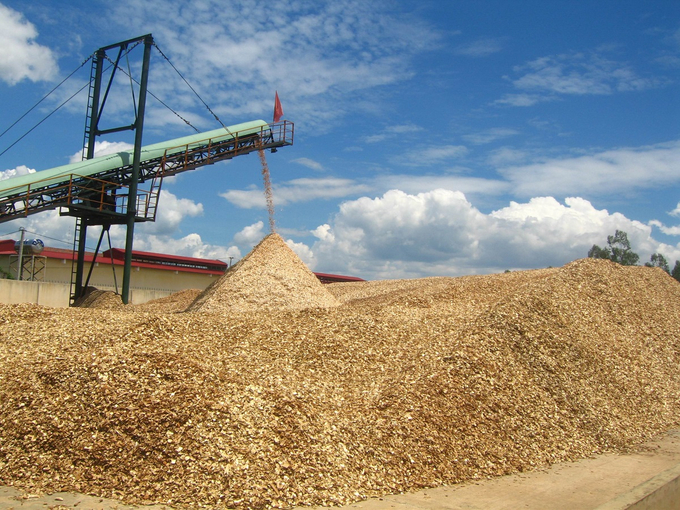
The woodchip processing factories in Binh Dinh are competing fiercely to obtain raw materials. Photo: V.D.T.
The price of plantation timber fluctuates constantly throughout the years, the price depends mainly on two items of wood pellets and wood chips. The output of woodchips was bottlenecked by the two big markets of China and Japan in 2017 and 2018, so the price of plantation timber in Binh Dinh dropped to around 800 to 900 thousand VND/ton. That is the price of plantation timber located in areas convenient for exploitation and transportation, and the prices are lower for plantation timber in highland and remote areas. The price of plantation timber in Binh Dinh reached only 1.3 million VND/ton in 2021.
However, starting from April 2022, due to the impact of the conflict between Russia and Ukraine, the world has suffered from a shortage of fuel, while the demand for fuel increased because European countries are approaching the winter season. As a result, the output of wood pellets and wood chips has been on the rise. The price of plantation timber in Binh Dinh peaked at over 1.7 million VND/ton, increasing by at leaset 400 thousand VND per ton.

Wood pellet factories in Binh Dinh also competed to obtain raw materials, pushing the price of plantation timber to its peak. Photo: V.D.T.
Competition for wood raw materials is taking place fiercely. Plantation timber in Binh Dinh is currently fought over by wood chip processing, pellet production and furniture processing factories. There is a large number of businesses operating in the wood industry, yet the area of plantation timber harvested annually is limited, so fierce competition in the purchase of raw materials is unavoidable. Many wood chip processing factories are currently struggling to find raw materials.
Namely, Quy Nhon Paper Material Co., Ltd in Binh Dinh, who owns 3 chip processing factories, including 2 high-tech factories and 1 craft factory. These factories produce an average of 700 tons of fresh wood chips every day. Quy Nhon Paper Material Co., Ltd. plans to export 80,000 tons of dry chips to the market annually, which is equivalent to 160,000 tons of raw wood. However, the output of imported wood materials in recent years has only reached less than half compared to the past because the supply of raw wood is very scarce.
At Song Kon Co., Ltd., a unit specializing in the production of wood chips in Phu Tai Industrial Park, Quy Nhon City, Binh Dinh province, the shortage of wood materials to meet daily production is serious concern.
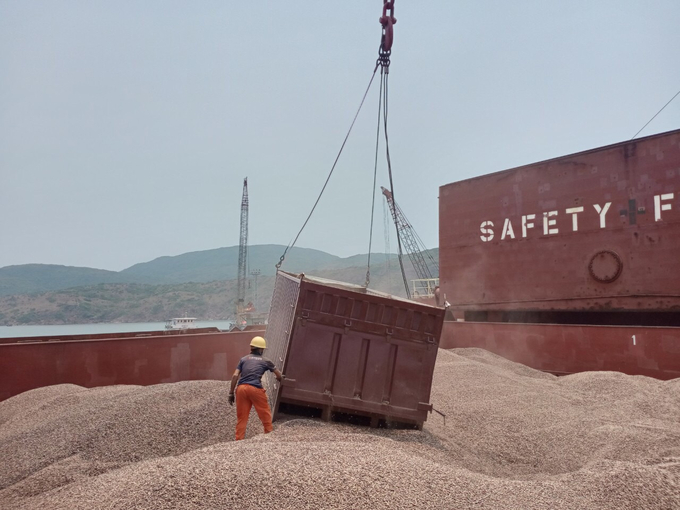
Wood pellets are being consumed very strongly by the market. Photo: V.D.T.
“Material wood is currently very scarce, if the company can purchase around 700 tons per day in the past, we can now only buy 400 tons. Since the beginning of the year, the company has exported more than 60,000 tons of dry wood chips to China. The selling price of 1 ton of dry wood chips at Quy Nhon Port is only 126 USD in 2021, the price has since increased to 160-165 USD/ton. However, due to the sharp increase in the price of input wood, the company can only earn a profit of aproximately 3-4 USD/ton”, explained Mr. Vo Van Toan, Director of Song Kon Co., Ltd.
The source of raw wood for wood chip and pellet processing factories in Binh Dinh is currently dependent on intermediaries; most businesses do not employ a dedicated force to purchase materials. Most processing businesses plant forests to actively source raw materials, but this self-sufficient source of raw materials is still unable to meet the high processing capacity.
For example, Quy Nhon Paper Material Co., Ltd., has planted 1,400 hectares of acacia in Dak Mang commune, Hoai An district, Binh Dinh since 2003. But only exploiting and replanting on an area of 30 to 50 hectares is not enough to meet the production capacity, so we have to rely on intermediaries. These intermediaries have connections with households everywhere, not only in Binh Dinh but also in Phu Yen, Gia Lai, Dak Lak, Kon Tum; timber planted in Quang Nam and Quang Ngai is also transported to Binh Dinh.
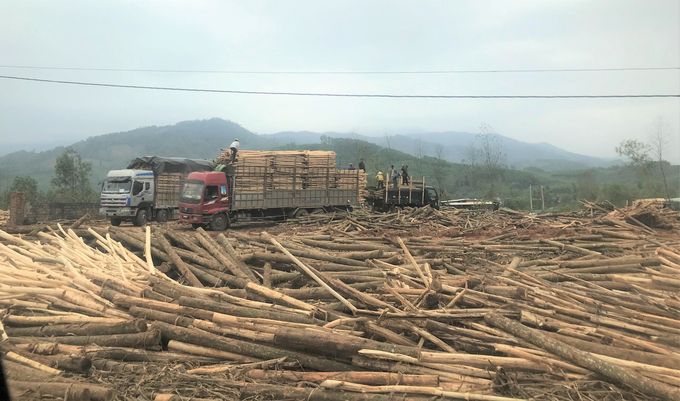
Plantation timber can easily purchased at high prices at the moment, so young forests are also exploited and sold by afforestation households. Photo: V.D.T.
Due to the increasing demand for raw wood, the wood chip processing and pellet production factories in Binh Dinh are no longer purchasing raw materials following strict requirements. In the past, plantation timber transported to the factory must meet various standards including: the log must be 2m long, sawed evenly and must be peeled off, the moisture must be in compliance with the specifications, only older wood is purchased, the wood logs must have an average diameter of 5cm or more, among many other requirements.
However, these standards are no longer applicable. Unpeeled wood logs are still purchased by the factory. In some cases, the acacia trees are extremely small but the factory accepts the losses and purchase the wood regardless.
“If the purchase of plantation timber remains as strict as it did before, the factory will not have raw materials for production. We have to arrange day and night duty, as soon as wood arrives at the factory, we have to handle immediately, otherwise they will sell it to another factory. The purchase of input is less strict and the price is high, yet the output of raw wood purchased daily is not half of what it used to be.
Previously, plantation timber is sawed and left suspended above the ground. The forest owner has now cuts the trees as close to the ground as possible, because each kilogram of wood can cost up to 1,700 VND”, said an official who purchases raw materials for a chip processing factory in Binh Dinh said.
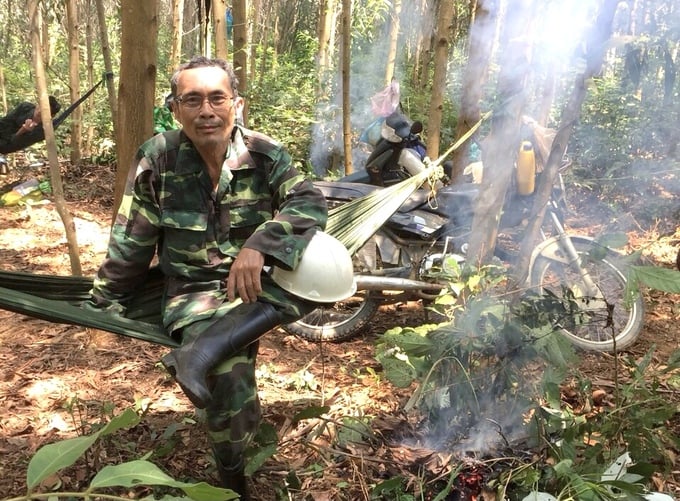
Mr. Do Duy Thuy, who owns nearly 100 hectares of forest in Canh Hien commune, Van Canh district, Binh Dinh is still determined to raise large timber forests. Photo: V.D.T.
Binh Dinh currently has 128,510 hectares dedicated to timber plantations, 10,000 of which are exploited and replanted every year, the output ranges from 1 to 1.2 million tons of raw wood per year. In the context of the high price of plantation timber, and unregulated purchasing by factories, afforestation households in Binh Dinh with a new forest area of at least 3 years old are also exploiting and selling off, rather than waiting for old trees as before. However, they do not know that exploiting young forests even at high prices is not profitable.
“Many people are greedy when they see high prices so they exploit young forests and sell them, but this is not profitable. As a matter of fact, young forests are too light, old acacia trees weigh significantly more. Forest trees from the 4th year onwards can grow extremely quickly even without fertilizer. Only when the forest trees reach 8 to 10 years old will it be profitable to wood processing factories at high prices, bringing benefits in many aspects.
Therefore, nearly 100 hectares of my forest in Van Canh, I am determined to raise it into a new large timber forest, planting in a rushed manner would be a waste of resources", said Mr. Do Duy Thuy, owner of nearly 100 hectares of forest in Canh Hien commune, Van Canh district, Binh Dinh.
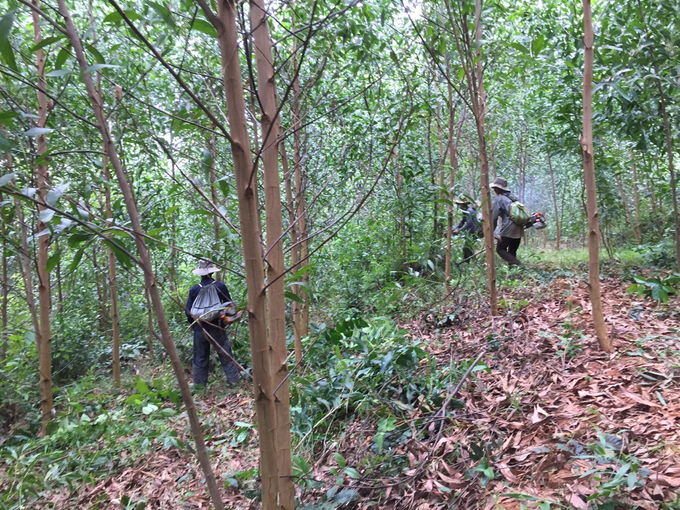
Mr. Thuy hires workers to prune his forest and grow large timber forests. Photo: V.D.T.
Binh Dinh strives to reach 30,000 hectares of large timber forests in the area by 2030, the average productivity of planted forests will be 25 to 30m3/ha/year for large timber trees; improve the quality and productivity of planted forests to achieve a large timber reserve of 190-240m3/hectare for 12-year forests and 100-120m3/ha for 7-year forests; the average large timber output reaches 50 - 60%.
However, with the current state of planted forests being exploited too young and sold off completely, the provincial authorities are concerned that the strategy to develop plantation timber in the area will face difficulties in the implementation.
Translated by Nguyen Hai Long

(VAN) Japan's efforts to lower the price of rice through the release of its stockpile may finally be making some progress, albeit at a snail's pace.

(VAN) U.S. tariffs are not only a 'shock', but also an opportunity for Vietnamese businesses to renew their mindset toward comprehensive development.

(VAN) As Bac Giang lychee enters the harvest season, Minister Do Duc Duy expects that the fruit will contribute greatly to agricultural exports due to standardized production and deep processing.

(VAN) Consumers have shown a preference for free-range eggs, but those farming systems are more vulnerable to biosecurity risks like bird flu.
/2025/05/09/5701-1-184335_301.jpg)
(VAN) Vietnam’s eel exports nearly doubled thanks to a mud-free farming model, opening up new prospects while still facing numerous barriers related to international standards.

(VAN) Minister Do Duc Duy warned that if production is not professionalized and supply chains are not transparent, the U.S. market could become a growth bottleneck.
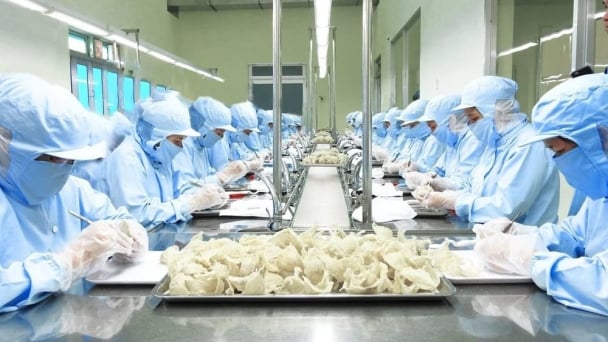
(VAN) Delegating surveillance responsibilities to local authorities is a cost-saving and efficiency-boosting measure that removes a key bottleneck for enterprises, according to Director General Duong Tat Thang.